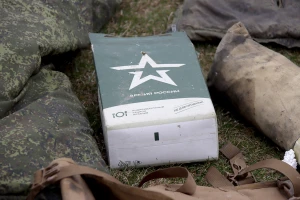
Water level in Inhulets River rises due to Kakhovka HPP dam destruction
As of the morning of June 8, the average flooding level stands at 5.61 meters. 600 square kilometers of the Kherson region are under water. The water level in the Inhulets River is rising
Oleksandr Prokudin, the head of the Kherson regional military administration, informs about this.
Despite the extreme danger and ongoing shelling by the Russians, the evacuation from the flooded areas is still in progress, according to Prokudin.
As of 06:00, a total of 1,999 civilians have been relocated from the hazardous zones. The largest number of evacuees, 1,495 people, came from the Korabel neighborhood.
Approximately 600 square kilometers of the Kherson region have been submerged, with the right bank accounting for 32% and the left bank for 68% of the flooded area. The average flooding level stands at 5.61 meters.
"People are exhausted but provided with food and shelter. They don't want to move further to other regions," Prokudin added.
He reminded everyone that they should contact the regional authority hotline or the rescue services for evacuation.
The State Emergency Service reported that by 08:00, a total of 1,995 individuals, including 103 children, had been evacuated.
Furthermore, 334 civilians, including 15 children, were rescued, and 168 Ukrainians received psychological assistance.
Preliminary data indicates that 20 settlements and 2,629 houses have been flooded on the right bank of the Dnipro River.
Water in the Inhulets River rises due to Kakhovka HPP dam destruction
Five more settlements of the Kalynivka community, Kherson region, are under the threat of flooding.
The water is coming close to the houses of local residents. Due to the bridge being submerged, it is impossible to get to the village of Zapovit.
The Kherson Regional Military Administration reports that in Tokarivka, Poniativka, Novotiahyntsi and Ivanivka, the water level has dropped by an average of 20 centimeters and is now 6.15 meters. In Tokarivka, 2 non-residential buildings are flooded, and in Poniativka, 5 houses are flooded.
In Mykilske village, the water level has dropped by 50 centimeters and is now 6.15 meters. There are 15 houses flooded.
"In general, in the right-bank part of the region, the water level remains at the 5.61 meter mark," the statement said.
Danger and destruction levels
Regarding the situation at Ukrhydroenergo, they reported ongoing destruction of the spillway dam and the earth insert between the station building and the lock. As of 08:00, the reservoir level in the Nikopol area reached 13.05 meters.
To mitigate further flooding, adjustments are being made to the operation of hydroelectric power stations, and water is being stored above the Kakhovka Hydroelectric Power Plant in other reservoirs of the Dnipro Cascade. Ukrhydroenergo and Ukrhydroproject are also developing a project to construct a bridge over the Kakhovka Reservoir to restore the water level to its state prior to the explosion, as reported by the press service.
On the other hand, the Ministry of Internal Affairs of Ukraine is urging residents in coastal areas not to touch dangerous objects and to call 101 for assistance.
"The fast-moving current can dislodge landmines and unexploded ammunition, which can unexpectedly explode. These objects can also be carried ashore in flooded areas, posing great danger to people," warned the press service.
The situation in the south of Ukraine after the Kakhovka dam explosion
On June 6, occupying Russian forces blew up the Kakhovka HPP, completely destroying it. Evacuation efforts have begun to move residents away from the flooded areas. After that, President of Ukraine Volodymyr Zelenskyy convened an emergency meeting of the Security and Defense Council, and the world began to respond to the tragedy. Follow the detailed course of events here.
Ukraine’s government allocated UAH 1.5 billion for the construction of two new water supply systems. These systems will help provide drinking water to Kryvyi Rih, Nikopol, and Marganets. Additionally, almost UAH 846 million has been provided to ensure the drinking water needs of the Kherson, Mykolaiv, Zaporizhzhia, and Dnipropetrovsk regions.
According to initial estimates by the Ministry of Agrarian Policy, approximately 10,000 hectares of agricultural land on the right bank will be flooded due to the destruction of the Kakhovka HPP.
On June 7, the Ministry of Health warned of the potential outbreak of cholera and the risk of botulism resulting from the explosion of the HPP. They advised Ukrainians to consume only imported or bottled water and provided other recommendations to reduce the risk of infectious diseases.
By 3:00 p.m. on June 7, a total of 1,752 people, including 103 children, had been evacuated to safer locations in the Kherson region.
Flooding was reported in four districts of Mykolaiv on Tuesday evening. The water level rose by 82 cm, leading to the destruction and flooding of bridges and gardens in the region.
Furthermore, the only state sturgeon farm in Ukraine has been flooded, and the road to the temporarily occupied Kinburn Peninsula in the Mykolaiv region is completely submerged.
In contrast, as of 8:00 p.m., 196 residential buildings were flooded in the temporarily occupied Hola Prystan, with the water level still rising. However, the Ukrainian police successfully rescued a woman and children who were trapped in a flooded house in occupied Oleshky.
The flooding in the Kherson region has already resulted in the loss of lives. The mayor of Oleshky, Yevhen Ryschuk, reported three fatalities in the city due to the floods.
Turkish President Recep Erdogan believes that Ukraine should investigate the Kakhovka HPP explosion together with the Russians.
- News














































